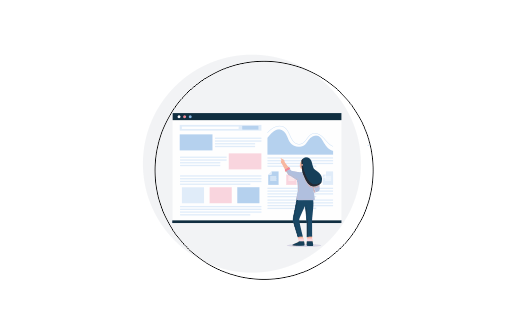

Transform your Products with
Modern Web Applications
for greater competitive advantage

Software is at the heart of your digital transformation journey, impacting customer experiences, operational processes and business models. It permeates every aspect of a modern business. Software allows you to improve and expand the way your business, products and services work. Sometimes, it even enables you to fundamentally restructure and transform them.
Web applications are an important aspect of modern software, providing great competitive advantage in your digital transformation. As Web applications are increasingly used to update and expand existing systems, and build new ones, newer ways of Web application development need to be considered to meet various complexities and challenges:

Today’s Web applications must be secure, and scalable to meet changes in demand. They also need to be available 24x7 across the world, accessible from multiple devices and screen sizes.

Modern Web applications have higher user expectations and greater demands than ever before. The quality of your software is crucial. It can directly impact the financial goals of your business.

Your Web applications need to be flexible to be able to respond quickly to fast-changing customer needs. Applications that provide superior user experience are key to staying competitive.

To meet market challenges, your business requires continuous improvement in value creation processes, backed by the adoption of new technologies. Agile and DevOps practices enable the accelerated delivery of quality, customer-focused software.

The key to staying competitive in today’s markets is to be open to adopting new technologies and methodologies. Your development teams need to be able to deploy new technologies continuously in existing and new business initiatives, rather than continue to rely on past investments.
Technology stacks form the backbone of modern Web application development. Selecting the right stack is key to the success of your project. Needless to say, a wrong one can negatively impact the project on effort, schedule, quality, and extensibility.
Do you have an effective Web apps strategy for your products and services?
Connect with us today to transform your offerings with modern Web apps.
Digital transformation is driving changes in Web applications. Today’s Web applications are:

Current Web application development involves the front-end comprising UI and the backend comprising services that power the front-end, a database and the required hardware infrastructure. Some of the current trends are described below.
HTML, CSS, and JavaScript™ form the foundation of front-end programming. HTML lays down the content of the website, CSS defines its looks i.e., font, color etc. and JavaScript makes the content dynamic, which allows content to be modified based on user actions or system events.
In recent times, we have seen a lot of buzz around frameworks, which are mostly created by open source communities. Their main objective is to implement common functionality faster and easier. Frameworks are also a rich source of best practices from practitioners. Some popular libraries and frameworks include:
jQuery® is one of the oldest JavaScript libraries that significantly reduces the effort to manipulate webpage elements. It has many plugins for common use cases of building interactivity and other general programming needs.
Bootstrap is a well-known CSS framework enables building responsive Web applications, which automatically adjust its layout for various screens sizes of mobile, tablet and desktop users.
React, a lightweight JavaScript library, open sourced by Facebook™ in 2013, is great for developing huge Web applications which are dynamic i.e., data changes on a frequent basis. React supports MVC pattern that promotes parallel development i.e., work simultaneously on different components of a Web application without impacting one another. Its one-way data flow means application data flows in a single direction, which means only the model can change the app’s state.
Angular is a popular model–view–viewmodel (MVVM) javascript framework powered by Google™ for building large-scale, feature-rich applications. Unlike model-view-controller (MVC) pattern, viewmodel acts as a binder that binds data between the view and model. Its two-way data binding that refers to the mechanism where UI fields are bound to model dynamically i.e., the model automatically changes when there are inputs on UI elements. It supports dependency injection, custom HTML tags, custom widgets and manipulation of DOM attributes through directive function.
Vue.js is a very lightweight JavaScript framework, launched in 2013. It is perfect for developing highly adaptable user interfaces and sophisticated Single-page Web applications. Vue.js supports MVVM pattern and provides two-way data binding between view and model.
In addition to these, there are many other JavaScript libraries and frameworks such as Backbone.js, Ember.js, Knockout, Moment.js and Zepto for faster and easier Web application development.
Backend Web frameworks helps developers to simplify and speed-up backend development for Web applications. Some popular frameworks include:
ASP.NET is an open-source server-side Web application framework to build dynamic Web sites, Web applications and Web services. Originally developed by Microsoft®, it provides useful features on top of .NET platform to help programmers in expediting development: base framework for processing Web requests, Web-page template syntax for building dynamic Web pages, libraries for MVC pattern, complete authentication system for internal and external identity providers.
Django is a Python-based open source web application development framework mainly suited for database-driven web application and websites. Its model-view-template (MVT) architecture makes it highly reusable and customizable. We can swap template framework, ORM and database to other alternatives. It follows MVVM pattern and all requests go through urlresolvers, middleware, view and context processors.
Node.js®, a JavaScript runtime, is also used for backend programming. It is based on an event-driven, asynchronous I/O model that makes it ideal for data-intensive real-time applications. Express is a flexible and fast framework developed on top of Node.js, which offers a thin layer of core application along with main features of Node.js. Its powerful routing API simplifies the job of implementing rest APIs.
Laravel™ is a PHP framework that follows the MVC architecture pattern. Laravel attempts to simplify the most common tasks such as authentication, routing, sessions and caching by providing reusable code. It also provides command line tools and other helper functions to make the development an enjoyable and creative experience.
Ruby on Rails® is the most popular Web framework written using the Ruby programming language. It runs on Linux and supports MVC architecture. Developers can add their code for views and models in environment tracks. It also provides a comfortable coding, compilation, and testing environment.
In addition to these, there are few more backend frameworks such as Flask, Hibernate, Pyramid, Phoenix and Spring.
The most popular relational databases for Web applications include MySQL™ and PostgreSQL®, while MongoDB® is a popular, document oriented, non-relational database.
There are many other database options from cloud providers like AWS®, Microsoft Azure® and Google Cloud™.
To reduce traffic on the database, a Web application generally uses a caching system, such as Memcached and Redis.
Are you facing challenges in implementing Web apps for your products and services?
Connect with us today to leverage our Web app expertise.
At Celstream, with nearly two decades of experience in delivering product engineering services for diverse and complex products and apps, we understand what it takes to develop modern Web applications, to help implement your digital transformation strategy.
We have extensive expertise in working with popular Web application frameworks, libraries and databases.
Our product engineering services teams are experienced in the following:

TRANSFORM YOUR
PRODUCTS AND SERVICES TODAY!